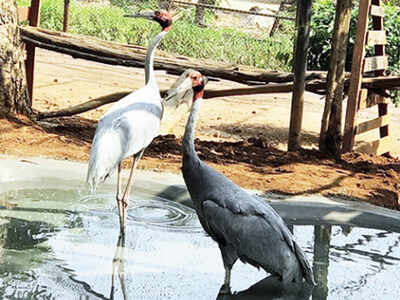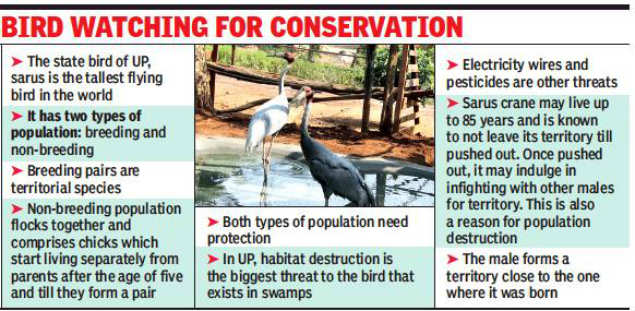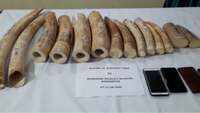
LUCKNOW: In an attempt to conserve sarus cranes, the state bird of Uttar Pradesh, the forest department is set to prepare an ‘atlas’ of this avian species.

The work on atlas will take off after the sarus census, the first phase of which will be conducted on Wednesday.
The forest department, in association with the Institute of Wildlife Sciences, Lucknow University, will collect and compile data for the atlas which will map the nesting, breeding and feeding sites of sarus cranes. Deputy chief wildlife warden, Uttar Pradesh, Anand Srivastava said the Sarus Protection Society has roped in the Lucknow University for the project.
“The training of our staff and other field workers, who will carry out the sarus census, has been done by the Institute of Wildlife Sciences. The effort is aimed at collecting scientific data,” Srivastava said.
Sarus Protection Society was formed by the UP government in 2006 for the conservation of UP’s state bird. The society has representation from forest department, private organizations and individuals who are working towards conservation of sarus cranes. The society conducts sarus census twice every year, in April and October.
UP has the maximum number of sarus and its population is mainly concentrated in Etawah, Mainpuri and Shahjahanpur.
“The first phase of the census that we will take up on Wednesday will be a two-hour exercise (from 6am to 8am) in the morning and for about an hour-and-a-half in the evening. The census will be conducted in all the districts at the same time,” said Prof Amita Kannaujia, coordinator, Institute of Wildlife Sciences, LU.
The longitudinal and latitudinal position of the sites where sarus bird, its chicken and eggs are found will be recorded along with the photographs. The second phase will be conducted on December 16 and third phase on June 16 next year.
On the basis of the data collected in the census, an atlas will be prepared which will make studies on conservation, breeding and habitats of sarus easier.
KS Gopi Sundar, a National Geographic explorer and co-chair at International Union for Conservation of Nature (IUCN), Stork, Ibis and Spoonbill Specialist Group, said: “There are two types of sarus population, breeding pairs and non-breeding flocks. In UP, at least 50% of sarus population is non-breeding.”
Sundar, a sarus conservationist of international repute, has worked extensively in UP and is also a member of Sarus Protection Society.

The work on atlas will take off after the sarus census, the first phase of which will be conducted on Wednesday.
The forest department, in association with the Institute of Wildlife Sciences, Lucknow University, will collect and compile data for the atlas which will map the nesting, breeding and feeding sites of sarus cranes. Deputy chief wildlife warden, Uttar Pradesh, Anand Srivastava said the Sarus Protection Society has roped in the Lucknow University for the project.
“The training of our staff and other field workers, who will carry out the sarus census, has been done by the Institute of Wildlife Sciences. The effort is aimed at collecting scientific data,” Srivastava said.
Sarus Protection Society was formed by the UP government in 2006 for the conservation of UP’s state bird. The society has representation from forest department, private organizations and individuals who are working towards conservation of sarus cranes. The society conducts sarus census twice every year, in April and October.
UP has the maximum number of sarus and its population is mainly concentrated in Etawah, Mainpuri and Shahjahanpur.
“The first phase of the census that we will take up on Wednesday will be a two-hour exercise (from 6am to 8am) in the morning and for about an hour-and-a-half in the evening. The census will be conducted in all the districts at the same time,” said Prof Amita Kannaujia, coordinator, Institute of Wildlife Sciences, LU.
The longitudinal and latitudinal position of the sites where sarus bird, its chicken and eggs are found will be recorded along with the photographs. The second phase will be conducted on December 16 and third phase on June 16 next year.
On the basis of the data collected in the census, an atlas will be prepared which will make studies on conservation, breeding and habitats of sarus easier.
KS Gopi Sundar, a National Geographic explorer and co-chair at International Union for Conservation of Nature (IUCN), Stork, Ibis and Spoonbill Specialist Group, said: “There are two types of sarus population, breeding pairs and non-breeding flocks. In UP, at least 50% of sarus population is non-breeding.”
Sundar, a sarus conservationist of international repute, has worked extensively in UP and is also a member of Sarus Protection Society.

Coronavirus outbreak
Trending Topics
LATEST VIDEOS
More from TOI
Navbharat Times
Featured Today in Travel
Quick Links
Kerala Coronavirus Helpline NumberHaryana Coronavirus Helpline NumberUP Coronavirus Helpline NumberBareilly NewsBhopal NewsCoronavirus in DelhiCoronavirus in HyderabadCoronavirus in IndiaCoronavirus symptomsCoronavirusRajasthan Coronavirus Helpline NumberAditya ThackerayShiv SenaFire in MumbaiAP Coronavirus Helpline NumberArvind KejriwalJammu Kashmir Coronavirus Helpline NumberSrinagar encounter
Get the app









